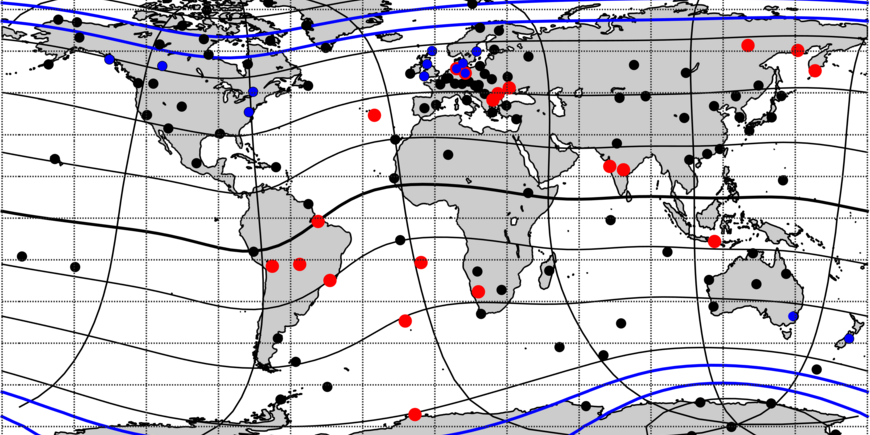21.10.2016: The geomagnetic field of the Earth serves as a natural protection against the solar wind. Changes in the intensity of the solar wind can cause disturbances in the geomagnetic field. With the Kp index the GFZ section Earth's Magnetic Field provides a measure of the intensity of the disturbances. “Kp” stands for planetary index (in German: “planetare Kennziffer”). Since yesterday, this index is part of the Space Situational Awareness Program of the European Space Agency, ESA.
The objective of the ESA program is to support Europe's independent utilisation of, and access to information and data regarding the space environment, and particularly regarding hazards to infrastructure, like satellite systems, in orbit and on the ground, for example in the form of interferences of electric currents in the ground with power lines. The ESA now provides the Kp index together with other indicators via its website to a broad range of users. A visible sign of an enhanced solar activity – a so called solar storm - are the polar lights. When solar activity is high, polar lights can be seen way down towards the mid-latitudes, even in Germany, for example: In such times, the Kp index reaches high values.
Thirteen selected geomagnetic observatories, that are located outside of the area of polar lights, measure disturbances in the Earth’s magnetic field and are used for the calculation of the global Kp index. At each station, some background disturbances and annual and daily signals have to be corrected for to obtain a measure of the magnetic disturbance from the solar wind. The mean value of all these corrected values gives the global Kp index, provided by the GFZ. In 1938, the local index was for the first time calculated for the Adolf Schmidt Observatory for Geomagnetism in Niemegk, close to Potsdam, that is now part of the GFZ. The global Kp index was introduced in 1949 and was officially acknowledged in 1951 by the International Association for Terrestrial Magnetism and Electricity. (ak)
>>More information on the Kp index
>>Kp index quiklook









![[Translate to English:] Torsten Sachs in front of a climate station on a field](/fileadmin/_processed_/3/9/csm__TorstenSachs_bearbeitet_GS_4a1365ef84.jpeg)

![[Translate to English:] left image flood at the Ahrtal: image from above, several houses are flooded; left image:: Heidi Kreibich;](/fileadmin/_processed_/4/4/csm_Bild2_9af0130e9f.png)



![[Translate to English:] Start der Vega Rakete](/fileadmin/_processed_/6/4/csm_20231201-kachel_Vega-VV23-launch_ESA-CNES-Arianespace_706716b68c.jpeg)









![[Translate to English:] Poster exhibition at the Brandenburg Hydrogen Day at the GFZ, some participants in the foreground](/fileadmin/_processed_/6/5/csm_Erster_Brandenburgischer_Wasserstofftag_GFZ_402fcec95e.jpeg)
![[Translate to English:] Group picture of the participants](/fileadmin/_processed_/9/4/csm_20231108_CAWa-Workshop-Tashkent_Gruppenbild_99ea779d8a.jpeg)

![[Translate to English:] [Translate to English:] Hörsaal](/fileadmin/_processed_/e/6/csm_H%C3%B6rsal_e21ac645fb.jpeg)


![[Translate to English:] The Delegations in the Historic Library on the Telegrafenberg. In the back there are from left to right, the Dutch Ambassador for Germany, Ronald van Roeden, the Dutch Minister for Education, Culture and Science, Robbert Dijkgraaf and the scientific director of the GFZ, Susanne Buiter.](/fileadmin/_processed_/d/b/csm_Kachel-2_9eba4b4212.jpeg)

